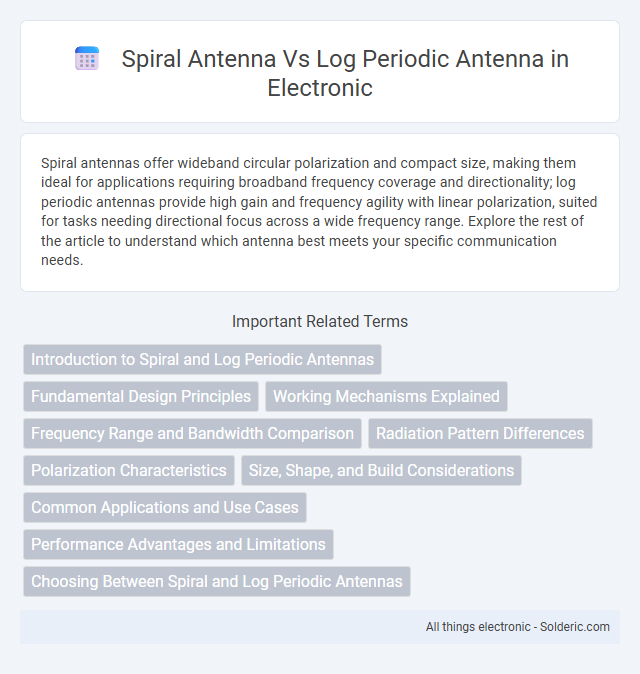Spiral antennas offer wideband circular polarization and compact size, making them ideal for applications requiring broadband frequency coverage and directionality; log periodic antennas provide high gain and frequency agility with linear polarization, suited for tasks needing directional focus across a wide frequency range. Explore the rest of the article to understand which antenna best meets your specific communication needs.
Comparison Table
| Feature | Spiral Antenna | Log Periodic Antenna |
|---|---|---|
| Frequency Range | Ultra-wideband, typically several octaves | Wideband, covering multiple decades |
| Polarization | Typically circular polarization | Linear polarization |
| Radiation Pattern | Broadbeam, frequency independent | Directional with moderate gain |
| Gain | Low to moderate (5-8 dBi) | Moderate to high (6-10 dBi) |
| Size | Compact for wide bandwidth | Physically larger, scales with lowest frequency |
| Applications | Wideband communications, EMC testing, radar | TV antennas, wideband communication, direction finding |
| Impedance | Typically 50 ohms, stable over frequency | Characteristic impedance varies, usually ~50-75 ohms |
Introduction to Spiral and Log Periodic Antennas
Spiral antennas are frequency-independent antennas known for their wideband and circular polarization characteristics, often used in applications requiring broad frequency coverage. Log periodic antennas, characterized by their self-similar structure, provide consistent gain and impedance over a wide frequency range, making them ideal for broadband communication systems. Both antenna types serve critical roles in modern wireless systems, with spiral antennas excelling in broadband polarization diversity and log periodic antennas in directional broadband performance.
Fundamental Design Principles
Spiral antennas utilize a continuous, logarithmic spiral shape that allows for broadband frequency response and circular polarization, relying on frequency-independent geometry to maintain consistent radiation patterns. Log periodic antennas consist of a series of dipole elements with lengths and spacing following a logarithmic progression, enabling multi-band operation through frequency-dependent resonance of individual elements. Your choice depends on whether you need ultra-wideband circular polarization (spiral) or highly directional, multi-frequency performance (log periodic).
Working Mechanisms Explained
Spiral antennas operate using a frequency-independent design where currents travel along the spiral arms, creating circularly polarized waves ideal for broadband applications. Log-periodic antennas function through a series of dipole elements of varying lengths, sequentially activated across frequency bands to maintain consistent impedance and radiation characteristics. Your choice depends on whether you require ultra-wideband circular polarization (spiral) or directional broadband performance with linear polarization (log-periodic).
Frequency Range and Bandwidth Comparison
Spiral antennas offer ultra-wideband frequency coverage, typically spanning from hundreds of MHz to several GHz, making them ideal for applications requiring wide frequency agility. Log periodic antennas provide broad bandwidth as well, but their frequency range is more discrete and dependent on the element spacing, usually covering one to two octaves. When selecting between the two, your choice should consider the required frequency range precision and bandwidth adaptability for optimal performance in your communication system.
Radiation Pattern Differences
The spiral antenna exhibits a broad, nearly uniform radiation pattern ideal for wideband and circularly polarized signals, offering consistent coverage across a wide frequency range. In contrast, the log periodic antenna features a directional radiation pattern with significant gain along its main axis, making it suitable for applications requiring focused signal reception or transmission over a specific frequency band. Your choice depends on whether you need omnidirectional coverage with polarization flexibility or directional performance with high gain.
Polarization Characteristics
Spiral antennas exhibit circular polarization, enabling consistent signal reception regardless of the wave's orientation, which is ideal for applications requiring wide-angle coverage and minimal polarization mismatch. Log periodic antennas typically provide linear polarization, offering high gain and directivity but requiring alignment with the incoming wave's polarization for optimal performance. Your choice depends on whether you need versatile polarization coverage (spiral) or focused linear polarization with gain (log periodic).
Size, Shape, and Build Considerations
Spiral antennas are compact, planar structures with a continuous, curved shape that enables wideband frequency coverage and circular polarization, making them suitable for limited-space applications. Log periodic antennas feature a series of varying-length dipole elements arranged in a linear or planar form, resulting in a larger overall size that supports wide frequency range and directional radiation patterns. Construction of spiral antennas emphasizes precision in the spiral geometry on flat substrates, while log periodic designs require careful spacing and element tapering to maintain consistent impedance and gain across frequencies.
Common Applications and Use Cases
Spiral antennas are commonly used in wideband communication systems, radar, and electronic warfare due to their circular polarization and broad frequency range capabilities. Log periodic antennas find frequent application in television broadcasting, wireless communication, and electromagnetic compatibility testing because of their directional gain and consistent performance over multiple frequencies. Your choice depends on specific needs for frequency coverage and polarization in applications like satellite communication or spectrum monitoring.
Performance Advantages and Limitations
Spiral antennas offer broadband circular polarization and compact size, making them ideal for applications requiring wide frequency coverage and consistent signal quality. Log periodic antennas provide high gain and directional performance over a wide bandwidth but tend to be larger and more complex in design. Your choice depends on whether you prioritize wideband circular polarization with compact form or directional gain with a larger footprint.
Choosing Between Spiral and Log Periodic Antennas
Spiral antennas offer wideband circular polarization ideal for satellite and radar applications, while log periodic antennas provide high gain and directional broadband performance suited for communication and signal scanning. Your choice depends on requirements like polarization type, frequency range, and directivity; spiral antennas excel in compact size and broad frequency coverage, whereas log periodic antennas are better for focused, long-range reception. Consider the specific use case to determine which antenna maximizes efficiency and system performance.
spiral antenna vs log periodic antenna Infographic

 solderic.com
solderic.com